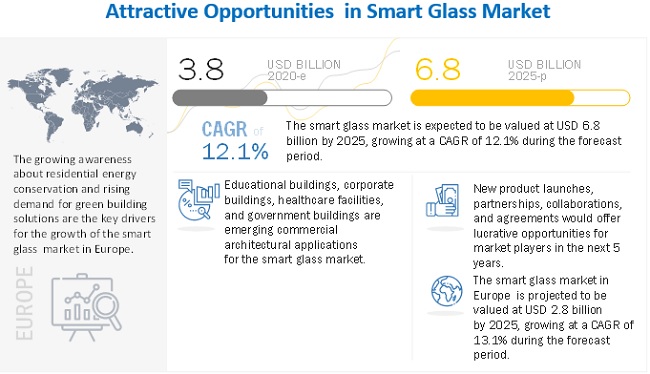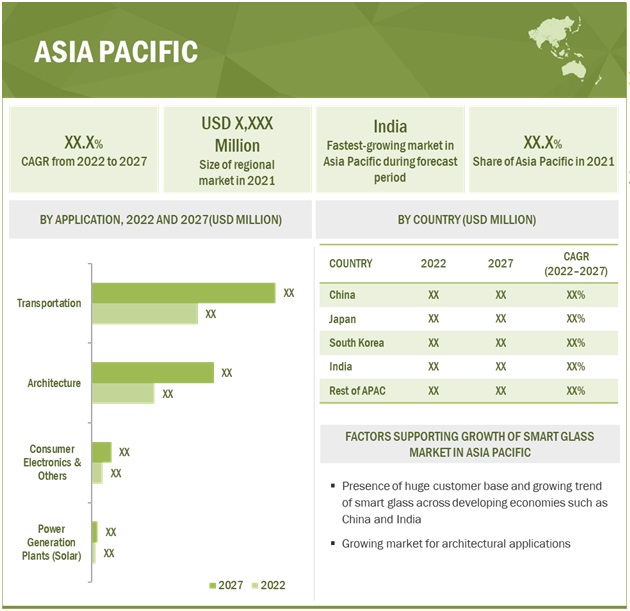Smart Glass Market with COVID-19 Impact by Technology (Suspended Particle Display, Electrochromic, Liquid Crystal), Application (Architecture, Transportation, Consumer Electronics), and Geography - Gl
The smart glass market size is expected to grow from USD 3.8 billion in 2020 to USD 6.8 billion by 2025, at a CAGR of 12.1% during the forecast period. The growth of the smart glass industry is driven by factors, such as the growing adoption of smart glass in automotive application and, declining prices for eletrochromic material.Other major driving factors for smart glass adoption include supportive government mandates and legislation on energy efficiency. Governing bodies of various countries are increasingly encouraging the use of these energy-efficient products. Smart glass has inherent energy-saving and auto-dimming properties, which reduce its maintenance cost. As a result, the perceived benefits of these glass products are more than the incurred investments.

COVID-19 impact on the smart glass market
COVID-19 has severely impacted the growth of the global smart glass industry. Global sales of smart glass for major applications such as architecture and automotive are expected to decline by 10–15% in this fiscal year, depending upon the progression of the virus in different parts of the world. The decline in the number of new construction projects and the temporary shutdown of manufacturing facilities are some of the factors hampering the growth of the smart glass market. However, the short-term supply chain disruptions are expected to affect market growth in key regions. COVID-19 has severely impacted the global automotive industry, wherein a number of automobile production facilities across the world have been shut down. Global automotive sales are expected to decline by 8–10% in this fiscal year, depending upon the progression of the virus.
Market dynamics
DRIVERS
- Growing demand for smart glass in automobile applications
The automobile industry is growing at a fast pace since its revival after the financial meltdown in 2008. Renewed consumer confidence in the economy and higher spending have driven up the sales of light- and heavy-duty vehicles. The demand for automotive glass is influenced by several factors. The replacement volume of glasses increases with an increase in the total vehicle population and number of miles driven. Severe weather and road conditions can also increase the demand for automotive glass repair and replacement. However, consumers tend to defer fixing minor damage to a windscreen until a vehicle trade-in or sale or vehicle inspection. Therefore, sales of new vehicles, turnover of used vehicles, and laws for vehicle inspection influence the demand differently for smart glass in the automotive application in countries.
Smart glass is ideal for automobile, aviation, and any other transportation applications requiring heat and glare control. In the automotive sector, smart glass is used in applications such as rearview mirrors, windows, sunroofs, and windshields. Smart glass provides protection from harmful ultraviolet (UV) rays, reduces glare, helps control the heat inside the vehicle, and reduces energy consumed over temperature maintenance.
RESTRAINTS
- Higher cost of smart glass
Smart glass was used for the first time in the 1980s, but the technology was commercialized after 2000. The smart glass industry has undergone many changes and advancements in terms of technologies and applications. The cost of smart glass is 2 to 4 times higher than that of conventional windows and glass due to significant technological advancements. The high cost of these glasses deters its large-scale adoption. Manufacturers find it difficult to quantify the ROI to end users and, hence, its major application can be found across the high-end and luxury verticals.
While the smart glass technology was introduced to the market almost a decade back, it is only in the last couple of years that manufacturers have secured the funding and support necessary to launch large volume production. With the opening of large volume manufacturing facilities, manufacturers are expected to achieve economies of scale, which, in turn, will lower the cost. With the increasing volume of production, the cost of smart glass is estimated to reduce by 30%–40%.
OPPORTUNITIES
- High potential in solar power generation plants
The cost associated with energy is constantly increasing; consequently, the demand for unconventional power sources has been on the rise over the last decade. Solar energy is one of the alternatives to conventional sources of energy. The performances of photochromic and thermochromic smart glasses are directly or indirectly dependent on sunlight. The use of such auto-dimmable smart glass helps reduce electricity consumption to a great extent, especially for heating and cooling systems.
One of the emerging applications of smart glass is solar power generation plants. Smart glass is used in Solar Panels to absorb the maximum amount of light to generate electricity. The solar power generation sector is expected to offer many opportunities for smart glass applications in the future.
CHALLENGES
- Lack of awareness of long-term benefits of smart glass
There is limited awareness in the market of the characteristic benefits of smart glass as the technology has only been commercialized for few applications across different verticals. The current stage of commercialization and adoption of smart glass in application areas such as automotive and architecture indicates the booming of the market, with industry participants and architects experiencing the benefits offered by the smart glass technology; as a result, this technology has gained a lot of traction in the past 2 years. However, there is a further need to educate the end users about its application as an energy-efficient, eco-friendly, and potential technology of the future.
Electrochromic technology segment to hold the largest share of the smart glass market during the forecast period
The electrochromic smart glass technology dominated the smart glass market. The electrochromic technology has long been used in rearview mirrors across the automotive sector. With the recent advancements, it has also found applications in switchable windows, sunroofs, and so on. Though the electrochromic smart window technology is not used much in the architecture or building applications, it is expected to revolutionize the architecture sector in the coming years, accounting for a major share of the market by 2025. Commercial buildings (corporate and government) are expected to be early adopters of the electrochromic technology.
Transportation application to hold the largest market size during the forecast period
The transportation application is expected to be largest share of the smart glass market during forecast period, as many automobile manufacturers have been incorporating smart glass materials in their vehicle designs to benefit from its antiglare property, remote access capacity, and dynamic light emission adjustment properties. In transportation another major application area for smart glass are in the form of doors, windows, sunroofs, windshields, rearview mirrors, and skylights. Smart glasses help minimize heat generation, provide shading, limit the viewing scope, and offer privacy to users.
UK is expected to hold the largest market size during the forecast period
UK is expected to lead the overall smart glass market in the coming years. Technological advancements and a recovering economy act as driving factors during the growth period. Rapidly increasing energy cost is likely to trigger the demand for energy-efficient products. The ability of smart glass to reduce the overall energy consumption of a building while offering attractive features such as on-demand privacy or glare-control is expected to multiply its applications.In extreme weather conditions prevalent in several areas of Europe, smart glass offers a suitable solution for maintaining the internal temperature of buildings or vehicles, thus saving the overall energy costs.






